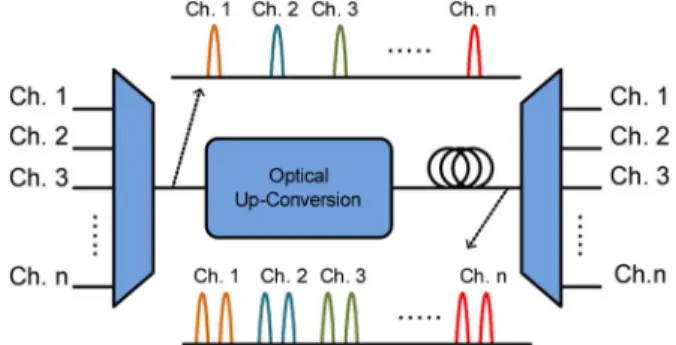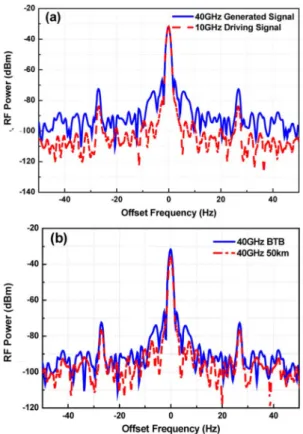IEEE PHOTONICS TECHNOLOGY LETTERS, VOL. 20, NO. 12, JUNE 15, 2008 1027
Optical Millimeter-Wave Signal Generation
Using Frequency Quadrupling Technique
and No Optical Filtering
Chun-Ting Lin, Po-Tsung Shih, Jason (Jyehong) Chen, Wen-Qiang Xue, Peng-Chun Peng, and Sien Chi
Abstract—This letter demonstrates a novel method to generate high-purity optical millimeter-wave signals with carrier suppres-sion by using a frequency quadrupling technique. To the authors’ knowledge, this is the first time that a frequency quadrupling system requires only a single integrated Mach–Zehnder modu-lator without a narrowband optical filter to remove undesired optical sidebands. Since no optical filter is needed, fast frequency tuning is straightforward and this approach will be particu-larly attractive for optical up-conversion in wavelength-division-multiplexing radio-over-fiber systems. This letter provides both theoretical analysis and experimental demonstration. The gener-ated optical millimeter-wave signals have very high quality with an optical carrier and harmonic distortion suppression ratio of more than 38 and 36 dB at 40 and 72 GHz, respectively.
Index Terms—Mach–Zehnder modulator (MZM), optical fre-quency multiplication, optical millimeter-wave, radio-over-fiber (RoF).
I. INTRODUCTION
W
ITH THE accelerated development of wireless commu-nications, efficient and cost-effective methods of gener-ating and transmitting microwave/millimeter-wave signals are of utmost importance. The generation and transmission of mi-crowave/millimeter-wave signals over an optical fiber have been intensively investigated for various applications, such as broad-band wireless access networks, phase-array antennas, optical sensors, antenna remoting, and radars [1]–[7]. The advantages of using optical fiber as a millimeter-wave signal transmission medium lie in the almost unlimited bandwidth and very low propagation loss. However, the generation of optical millimeter-wave signals at frequencies above 40 GHz remains a major chal-lenge which is limited by the frequency response of an LiNbO Mach–Zehnder modulator (MZM), typically less than 40 GHz,Manuscript received January 2, 2008; revised February 12, 2008. This work was supported in part by the National Science Council of the Republic of China, Taiwan, under Contract NSC 96-2221-E-155-038- MY2, Contract NSC 96-2752-E-009-004-PAE, Contract NSC 96-2628-E-009-016, and Contract NSC 95-2112-M-260-001-MY2.
C.-T. Lin, P.-T. Shih, and J. Chen are with the Department of Photonics, National Chiao Tung University, Hsinchu 300, Taiwan, R.O.C. (e-mail: jinting@ms94.url.com.tw; boris.eo95g@nctu.edu.tw).
W.-Q. Xue and P.-C. Peng are with the Department of Applied Materials and Optoelectronic Engineering, National Chi Nan University, Taiwan, R.O.C.
S. Chi is with the Department of Electrical Engineering, Yuan Ze University, Taiwan, R.O.C.
Color versions of some of the figures in this letter are available online at http:// ieeexplore.ieee.org.
Digital Object Identifier 10.1109/LPT.2008.923739
Fig. 1. Optical up-conversion using a frequency multiplication technique for WDM RoF systems.
or phase modulator (PM). Additionally, the electrical compo-nents and equipments at frequencies over 40 GHz, such as am-plifiers, mixers, and synthesizers, are very expensive. Therefore, a cost-effective way of generating of optical millimeter-wave signals beyond 40 GHz is of great interest.
Numerous optical millimeter-wave signal generation schemes using an MZM or PM to achieve frequency mul-tiplication have been recently demonstrated [1]–[7], [9]. However, these proposed systems need either more than one optical filter to remove undesired optical sidebands [2]–[7], [9] or two cascaded external modulators [7], which significantly increase system complexity and cost. Additionally, the un-avoidable optical filtering severely hinders the implementation of optical up-conversion in wavelength-division-multiplexer (WDM) radio-over-fiber (RoF) systems, as shown in Fig. 1 and [8]. Therefore, the frequency quadrupling technique without optical filters is of great interest.
This letter demonstrates a novel frequency quadrupling ap-proach that can generate a carrier-suppressed optical millimeter-wave signal by using only one external modulator without op-tical filtering. The opop-tical carrier and harmonic distortion sup-pression ratio (OCHDSR) of the 40- and 72-GHz millimeter-wave signals which are generated by using 10- and 18-GHz driving signal can exceed 38 and 36 dB, respectively. Since the optical carrier and harmonic distortion are highly suppressed, the high-purity two-tone millimeter-wave light wave does not suffer from impairment due to fiber dispersion.
II. THEORETICALANALYSIS
Fig. 2 shows a conceptual diagram of optical carrier-suppressed millimeter-wave signal generation using a fre-quency quadrupling technique without any optical filter. An external integrated MZM that consists of three sub-MZMs
1028 IEEE PHOTONICS TECHNOLOGY LETTERS, VOL. 20, NO. 12, JUNE 15, 2008
Fig. 2. Optical up-conversion using a frequency multiplication technique for WDM RoF systems. (MZ: Mach–Zehnder modulator; EDFA: erbium-doped fiber amplifier; OSA: optical spectrum analyzer; ESA: electrical spectrum ana-lyzer).
is key to generating optical millimeter-wave signals [7]. One sub-MZM (MZ-a or MZ-b) is embedded in each arm of the main modulator (MZ-c). The optical field at the input of the integrated MZM is defined as
(1) where is the amplitude of the optical field and is the angular frequency of the optical carrier. MZ-a and MZ-b are both biased at the full point. Electrical driving modulation
sig-nals sent into MZ-a and MZ-b are and
, respectively. In addition, the MZ-c is biased at the null point. Therefore, the optical field at the output of the integrated MZM can be expressed as
(2) where the phase modulation index is . Expanding
the and using a
Bessel function, the output optical field can be rewritten as
(3) where is the Bessel function of the first kind of order . Within the typical modulation range of , the Bessel function monotonically decreases with . At , the
corresponding values of , and
are 0.4854, 0.0145, 2.0095 10 , and 5.4133 10 , respec-tively. Therefore, the optical sidebands with the order higher than can be ignored without significant errors, and the op-tical field can be further simplified to
(4)
Fig. 3. Experimental results of 40-GHz optical millimeter-wave signal. (a) Op-tical spectrum. The resolution is 0.01 nm. (b) OpOp-tical waveform (313 uW/div; 10 ps/div).
After square-law detection using a photodiode (PD), the pho-tocurrent can be expressed as
(5) where is the 45-GHz photodetector’s responsivity. The cross terms of (5) will generate the desired millimeter-wave signal and its harmonic distortion signals.
III. EXPERIMENTALRESULTS ANDDISCUSSION
To verify the proposed method, the experimental setup is illustrated in Fig. 2. The external integrated MZM is a commercially available LiNbO modulator with 3-dB bandwidth of 20 GHz. The optical carrier generated by the distributed-feedback laser with wavelength of 1544.5 nm is ap-plied to the integrated MZM via a polarization controller (PC). The frequency of the microwave signal is set at 10 or 18 GHz. The generated optical millimeter-wave signal is amplified with an erbium-doped fiber amplifier (EDFA) to compensate the MZM loss and then transmitted over 50-km single-mode fiber (SMF). The optical power is normalized to 1 dBm before PD detection.
Fig. 3(a) shows the measured spectrum of the optical 40-GHz millimeter-wave signal using 10-GHz driving signal before transmission. As can be seen, the optical carrier is effectively suppressed, and the power of the two second-order sidebands which are converted into 40-GHz electrical millimeter-wave signal after PD detection is 38 dB higher than that of the other order sidebands. Besides the second and sixth order sidebands, the other harmonic sidebands are observed due to the imbal-anced y-junction splitting ratio of the MZM. However, the suppression of the undesired harmonic sidebands can achieve more than 38 dB and induces a negligible influence on the performance of the optical millimeter-wave signal. Fig. 3(b) shows the waveform of the optical millimeter-wave signal with 50% duty cycle due to high OCHDSR.
Fig. 4 shows the electrical spectrum of the generated mil-limeter-wave signal with 40-GHz span and 30-kHz resolution bandwidth. A strong electrical output signal with frequency four times that of the driving signal is observed, and the first, second, and third terms of the electrical signal are totally suppressed. Fig. 5(a) shows that the linewidth of the generated 40-GHz signal is quite small and almost equal to that of the 10-GHz driving signal. After transmission over 50 km of SMF, no linewidth broadening of the electrical 40-GHz signal due to fiber dispersion is observed, as shown in Fig. 5(b). Limited by the bandwidth of available RF amplifier in our laboratory, the
LIN et al.: OPTICAL MILLIMETER-WAVE SIGNAL GENERATION USING FREQUENCY QUADRUPLING TECHNIQUE 1029
Fig. 4. Electrical spectrum of the generated 40-GHz millimeter-wave signal.
Fig. 5. Electrical spectrum of the generated 40-GHz millimeter-wave signal with 100-Hz span. (a) Comparison of generated 40-GHz signal and 10-GHz driving signal. (b) Comparison of generated BTB and following 50-km SMF transmission 40-GHz signal. The resolution bandwidth is 1 Hz.
optical 72-GHz millimeter-wave signal is also demonstrated using an 18-GHz driving signal. Fig. 6 shows that the optical power of the two second sidebands is 36 dB higher than that of the other sideband, which is good enough for most practical applications.
IV. CONCLUSION
In this letter, a novel frequency quadrupling technique for op-tical millimeter-wave generation is proposed. A two-tone light wave with frequency separation of four times the modulation frequency can be generated using only one external modulator
Fig. 6. Optical spectrum of the generated 72-GHz millimeter-wave signal using 18-GHz driving signal.
without optical filtering. Optical millimeter-wave signals of 40 and 72 GHz are generated from 10- and 18-GHz driving signals, respectively. The OCHDSR of these optical millimeter-wave signals can reach more than 36 dB. Since no optical filter is needed, the proposed scheme can be utilized in WDM RoF and continuously tunable millimeter-wave signal generation systems. Since the state-of-the-art MZM has an upper-limit frequency response around 40 GHz [7], the proposed method is capable of generating optical millimeter-wave signals up to 160 GHz.
REFERENCES
[1] X. Wei, J. Leuthold, and L. Zhang, “Delay-interferometer-based optical pulse generator,” in Proc. Optical Fiber Communication Conf. (OFC
2004), Paper WL6.
[2] G. Qi, J. Yao, J. Seregelyi, S. Paquet, and C. Belisle, “Generation and distribution of a wideband continuously tunable millimeter-wave signal with an optical external modulation technique,” IEEE Trans. Microw.
Theory Tech., vol. 53, no. 10, pp. 3090–3097, Oct. 2005.
[3] A. Wiberg, P. Perez-Millan, M. V. Andres, and P. O. Hedekvist, “Mi-crowave-photonic frequency multiplication utilizing optical four-wave mixing and fiber Bragg gratings,” J. Lightw. Technol., vol. 24, no. 1, pp. 329–334, Jan. 2006.
[4] Q. Wang, H. Rideout, F. Zeng, and J. Yao, “Millimeter-wave frequency tripling based on four-wave mixing in a semiconductor optical ampli-fier,” IEEE Photon. Technol. Lett., vol. 18, no. 23, pp. 2460–2462, Dec. 1, 2006.
[5] Z. Pan, S. Chandel, and C. Yu, “160 GHz optical pulse generation using a 40 GHz phase modulator and two stages of delayed MZ interferome-ters,” in Proc. Conf. Lasers Electro-Optics (CLEO 2006), Paper CFP2. [6] C. Yu, Z. Pan, T. Luo, T. Wang, L. Christen, and A. E. Willner, “Beyond 40-GHz return-to-zero optical pulse-train generation using a phase modulator and polarization-maintaining fiber,” IEEE Photon.
Technol. Lett., vol. 19, no. 1, pp. 42–44, Jan. 1, 2007.
[7] T. Kawanishi, T. Sakamoto, and M. Izutsu, “High-speed control of lightwave amplitude, phase, and frequency by use os electrooptic ef-fect,” IEEE J. Sel. Topics Quantum Electron., vol. 13, no. 1, pp. 79–91, Jan./Feb. 2007.
[8] J. Yu, Z. Jia, L. Yi, G. K. Chang, and T. Wang, “Optical millimeter-wave generation or up-conversion using external modulators,” IEEE
Photon. Technol. Lett., vol. 18, no. 1, pp. 265–267, Jan. 1, 2006.
[9] J. Kondo, K. Aoki, Y. Iwata, A. Hamajima, T. Ejiri, O. Mitomi, and M. Minakata, “76-GHz millimeter-wave generation using MZ LiNbO3 modulator with drive voltage of 7 Vp-p and 19 GHz signal input,” in Proc. Int. Topic Meeting Microwave Photonics (MWP 2005), Oct. 2005, pp. 1–4, Paper PDP-1.


